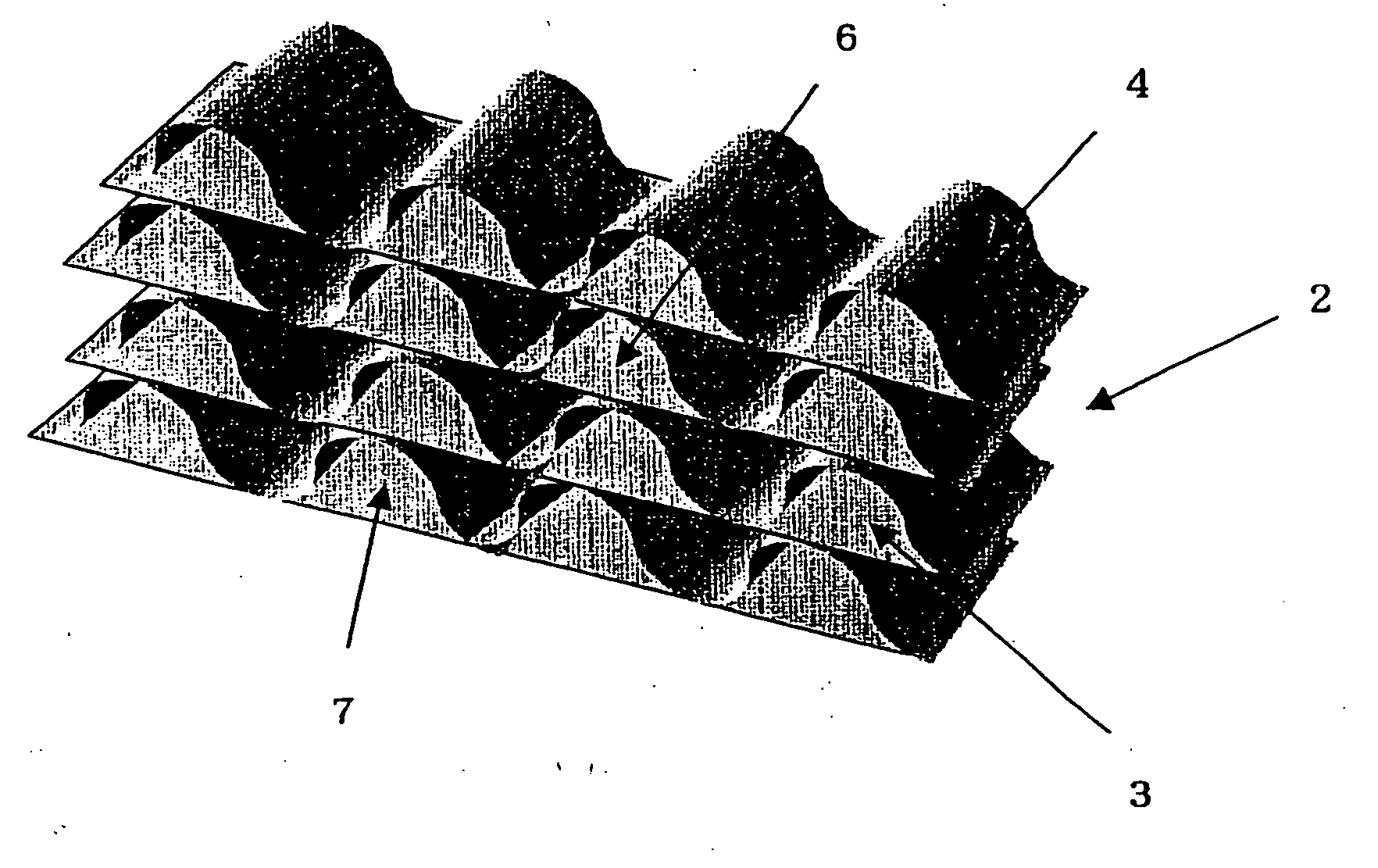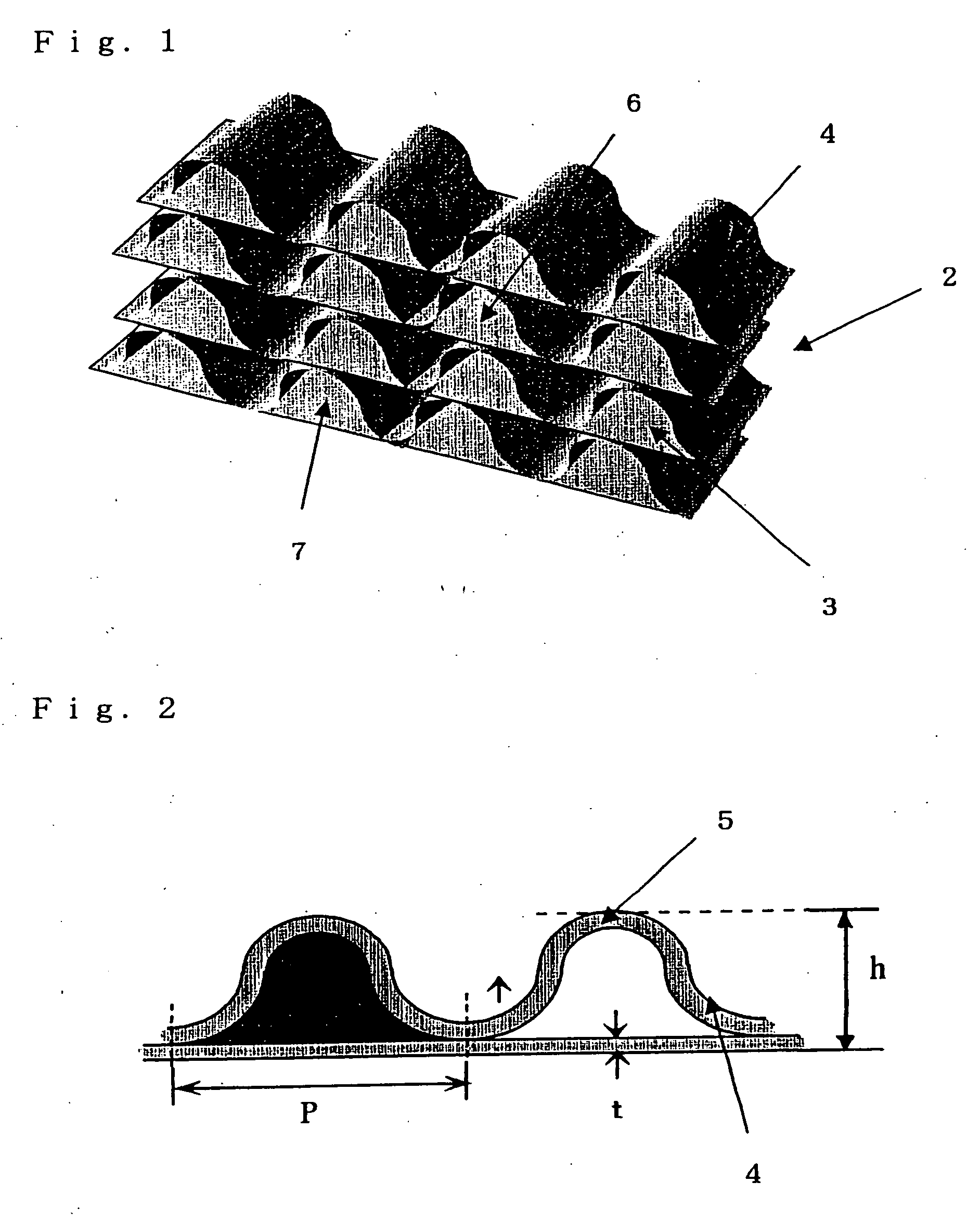Purification composition and filter for ozone-containing exhaust gas
a technology of purification composition and filter, which is applied in the direction of physical/chemical process catalyst, metal/metal-oxide/metal-hydroxide catalyst, and separation process, etc. it can solve the problems of difficult for such conventional ozone decomposition filter containing activated carbon, ozone is toxic, and oxygen in the air is oxidized by laser radiation to produce ozone, so as to reduce the content of ozone and volatile organic compounds, and effectively remove ozon
- Summary
- Abstract
- Description
- Claims
- Application Information
AI Technical Summary
Benefits of technology
Problems solved by technology
Method used
Image
Examples
example 1
(Preparation of Filter)
[0070] A flat fiber sheet with a fiber void of 90% and a thickness (t in FIG. 2) of 0.1 mm was prepared from a mixture of 25 wt % of E-glass fiber (average fiber diameter: 6 μm) and 75 wt % of ceramic fiber (SiO2:Al2O3=1:1, average fiber diameter: 3 μm) by a wet paper milling method. The flat fiber sheet was caused to pass through a pair of waveform corrugators to obtain a corrugated fiber sheet. After applying silica sol to the mountain parts of the corrugated fiber sheet as an adhesive, the flat fiber sheets were superposed and laminated. The corrugated fiber sheet and the flat fiber sheet were laminated in turn so that the air passages are aligned in the same direction, thereby obtaining a fiber supporting body having a corrugated honeycomb substrate shown in FIG. 1 and FIG. 2 with a center core pitch (p in FIG. 2) of 2.5 mm and a mountain height (h in FIG. 2) of 1.1 mm.
[0071] Next, a slurry was prepared by dispersing 75 parts by weight of activated carb...
example 2
(Preparation of Filter)
[0086] A filter C was prepared in the same manner as in Example 1, except that 90 parts by weight of activated carbon powder A and 10 parts by weight of manganese oxide were used instead of 75 parts by weight the activated carbon powder A and 25 parts by weight of manganese oxide. The amounts of the activated carbon powder A and manganese oxide carried on unit volume of the filter C were respectively 63 g / l and 7 g / l.
(Performance Evaluation 1)
[0087] The same test as in Example 1 was carried out using the filter C instead of the filter A. As a result, the gas after passing the filter C was confirmed to have a styrene content of 2 mg / m3 and an ozone content of 50 mg / m3.
(Performance Evaluation 2)
[0088] The same test as in Example 1 was carried out using the filter C instead of the filter A. As a result, the styrene removal rate was confirmed to be initially 98%, and 82% after 30 hours, the ozone decomposition rate was confirmed to be initially 95%, and 75...
example 3
(Preparation of Filter)
[0089] A filter D was prepared in the same manner as in Example 1, except that 75 parts by weight of activated carbon powder C and 25 parts by weight of manganese oxide were used instead of 75 parts by weight the activated carbon powder A and 25 parts by weight of manganese oxide. The amounts of the activated carbon powder C and manganese oxide carried on unit volume of the filter D were respectively 53 g / l and 18 g / l.
[0090] Activated carbon powder C: average particle diameter: 15.4 μm, total pore volume: 0.45 ml / g, specific surface area: 1,008 m2 / g, volume of pores A having a pore diameter of 0.4-0.8 nm: 0.33 ml / g, volume of pores B having a pore diameter of 0.4-2.0 nm: 0.42 ml / g, percentage C of the volume of pores having a pore diameter of 0.4-0.8 nm in the volume of pores having a pore diameter of 0.4-2.0 nm: 79%
(Performance Evaluation 1)
[0091] The same test as in Example 1 was carried out using the filter D instead of the filter A. As a result, the ...
PUM
| Property | Measurement | Unit |
|---|---|---|
| weight ratio | aaaaa | aaaaa |
| particle diameter | aaaaa | aaaaa |
| particle diameter | aaaaa | aaaaa |
Abstract
Description
Claims
Application Information
 Login to View More
Login to View More - R&D
- Intellectual Property
- Life Sciences
- Materials
- Tech Scout
- Unparalleled Data Quality
- Higher Quality Content
- 60% Fewer Hallucinations
Browse by: Latest US Patents, China's latest patents, Technical Efficacy Thesaurus, Application Domain, Technology Topic, Popular Technical Reports.
© 2025 PatSnap. All rights reserved.Legal|Privacy policy|Modern Slavery Act Transparency Statement|Sitemap|About US| Contact US: help@patsnap.com


